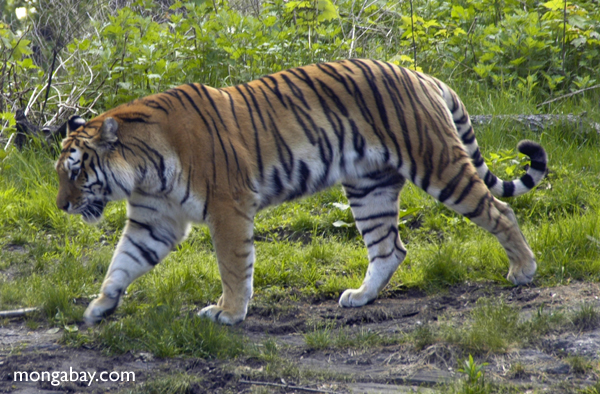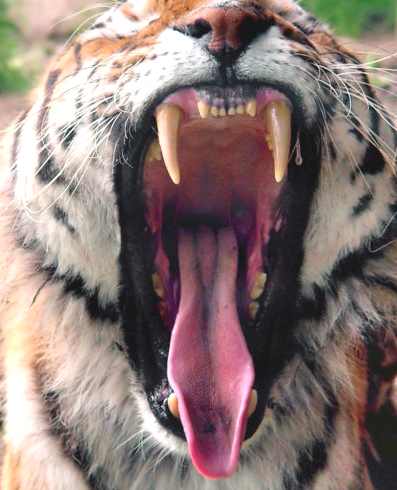Rebirth
Proud Member
Leopard Savaging a Crocodile Caught on Camera

More photos here:
http://www.telegraph.co.uk/earth/main.jhtml?xml=/earth/2008/07/18/ealeopard118.xml




actually thats kinda true, cos a Tiger would not be able to land a killer bite on a lions kneck cos of the "beard"^ Lions are the coolest. You can't get more manly than that god-like beard. A lion would beat a tiger with its beard alone. That's just a scientific fact.
The Lion (Panthera leo) is a mammal of the family Felidae. It is the second largest natural living feline with the exception of the tiger. The male lion, easily recognized by his mane, weighs between 150 and 190 kg (330 lb and 423 lb). Unlike tigers, very few lions exceed 225kg in the wild. The greatest wild lion on record is very large male with a weight of 311kg. Females are much smaller, weighing between 117 and 158 kg (240 lb and 330 lb). In the wild lions live for around 10–14 years, while in captivity they can live over 20 years.
Tigers (Latin: Panthera tigris) are mammals of the Felidae family and one of four "big cats" in the panthera genus. They are predatory carnivores and the largest and most powerful of all living cat species. The Indian subcontinent is home to more than 80% of the wild tigers in the world. Tigers breed well in captivity, and the captive population in the United States may rival the wild population of the world.
Most tigers live in forests and grasslands, for which their camouflage is ideally suited, and where it is easy to hunt prey that is faster or more agile. Among the big cats, only the tiger and jaguar are strong swimmers; tigers are often found bathing in ponds, lakes, and rivers. Tigers hunt alone and eat primarily medium-sized herbivores such as deer, wild pigs, and buffalo. However, they will also take larger or smaller prey on occasion. Humans are the tiger's only serious predator and often kill tigers illegally for their fur. Their bones and nearly all body parts are used in Chinese medicine for a range of purported uses including pain killers and aphrodisiacs. Poaching for fur and destruction of habitat have greatly reduced tiger populations in the wild, and it has been placed on the endangered species list.
Although different subspecies of tiger have different characteristics, in general male tigers weigh between 180 and 325 kg (400 lb and 715 lb) and females between 100 and 180 kg (220 lb and 400 lb). The males are between 2.6 and 3.3 metres (8 ft 6 in and 10 ft 9 in) in length, and the females are between 2.3 and 2.75 metres (7 ft 6 in and 9 ft) in length. Of the living subspecies, Sumatran tigers are the smallest, and Amur or Siberian Tigers are generally the largest.
Tigers have the longest and biggest canine teeth of all the wild cats. A tiger's canines are larger and longer than those of a similar-sized lion. The reason for this is likely due to the habit of preying on large herbivores in its habitat whose bones are thick and large; the tiger's canines have to be strong enough to break the bones of their prey. Moreover, as tigers hunt alone to bring down their prey, they have to work harder than lions, which hunt in groups.
igers often ambush their prey as do other cats (including the domestic cat). Tigers overpower their prey from any angle, using their body size and strength to knock prey off balance. Once prone, the tiger bites the back of the neck, often breaking the prey's spinal column, piercing their windpipe, or severing the jugular vein or carotid artery. For large prey, a bite to the throat is preferred. After biting, the tiger then uses its muscled forelimbs to hold onto the prey, bringing it to the ground. The tiger remains latched onto the neck until its prey dies.
Powerful swimmers, tigers are known to kill prey while swimming. Some tigers have even ambushed boats for the fishermen on board or their catch of fish.
In the wild world, tigers can leap as high as 5 m, and as far as 9 m -10 m, making them one of the highest-jumping mammals, perhaps second only to the puma. They have been reported to carry domestic livestock weighing 50 kg while easily jumping over fences 2 m high. Their forelimbs, heavily muscled, are used to hold tightly onto the prey's and avoid being dislodged, especially by large preys such as gaurs. A single tremendous blow of the paw can kill a full-grown wolf or heavily injure a 150 kg Sambar deer.
One common misunderstanding between lion and tiger needs to be corrected: Some people believe that tigers are built for hunting, while lions are for combating (e.g. defending their prides from intruders, fighting to gain posession of females), and tigers do not fight to the end. In reality, male tigers do have to fight to defend their ranges from intruders, as intruding males will try and kill their offspring, and gain access to females. Male tigers are very aggressive and do not tolerate any kind of territory overlapping. Sometimes the fights get so fierce the losers are dead or heavily injured, making them unable to catch their normal prey and starve. This contributes to the fact that wild tigers do not live as long as they do in zoos.
In the wild tigers mostly feed on deer, wild boar and wild cattle, including gaur and water buffaloes, young rhinos and elephants, and sometimes, leopards and bears. Sambar and wild boar are their favored preys in India. Young elephants are another of their favourite food items. However, as young calves and juveniles always travel in herds with their mothers and relatives, the possibility for a lone tiger to catch a young elephant is quite low, as the tiger usually have to deal with the calves' protectors, which outnumber it. Tigers prefer large preys such as sambar and gaur because they provide more meat and last for many days, avoiding the need for another hunt. In all of their range, tigers are the top predators and they do not fear from any other carnivores other than the dhole or Indian wild dog, which makes up for strength in numbers. They generally do not prey on large mammals such as elephants, and rhinos, although they will prey on weak young whenever they have an opportunity. However, a hungry tiger will attack anything it regards as potential food. Of all the land carnivores, tiger is the only species that has been known to charge and take down even full-grown male elephants, one-on-one. For centuries in Asia, especially in Indochina, where elephants used to be utilized in military as weapons, minor ethnic tribes, who are specialized in capturing and training elephants, have the traditions of testing captured male elephants by pressing one against a tiger. If an elephant survives the fight, it is considered ideal for battles. Today, however, due to the depletion of both species, these extraordinary confrontations become exceedingly rare and are hardly ever witnessed by humans in the wild.
I think I would put my money on the tiger!
Lion's are the coolest. You can't get more manly than that god-like beard. A lion would beat a tiger with its beard alone. That's just a scientific fact.
Except for the fact, that lions do not really live in the jungle but mostly in the Savanna... Tigers at the other hand live in jungles and woods!The beard trumps any and all arguments for opposers. Or "mane" if you want to get all technical and boring, but I'll go with beard. Also, lions are the king of the jungle in Disney movies, so therefore they're the king of the jungle.
Yes, me too... even though the crocodile does the same to other creatures, it doesn't seem right!I feel bad for the crocodile.
When a Tiger takes a full swing at you I don't think a beard will help much!






Tigers own.
Hi, Dee
Technically, they do not coexist in the wild. Grizzlies are actually a subspecies of the brown bear (Ursus arctos) and are found only in North America.
However, brown bears can also be found in Siberia, but they belong to another subspecies, the Siberian Brown Bear, which is about as big as Grizzly bears.
Do they meet with tigers? Yes, and they are deadly enemies. There are reports of tigers killing adult bears while they were hibernating, or sometimes attacking them when awake (tigers will usually attack only females and cubs, but some large males have also been taken down). However, bears are usually to powerful for even a tiger to handle. Recently, two large male Siberian tigers were killed by Brown bears. It seems that bears try to steal prey from tigers, and since tigers are not really into sharing, fights are common. Or they used to be, at least. Today there are only a few siberian tigers, and encounters with bears (which are also endangered), are rare.
